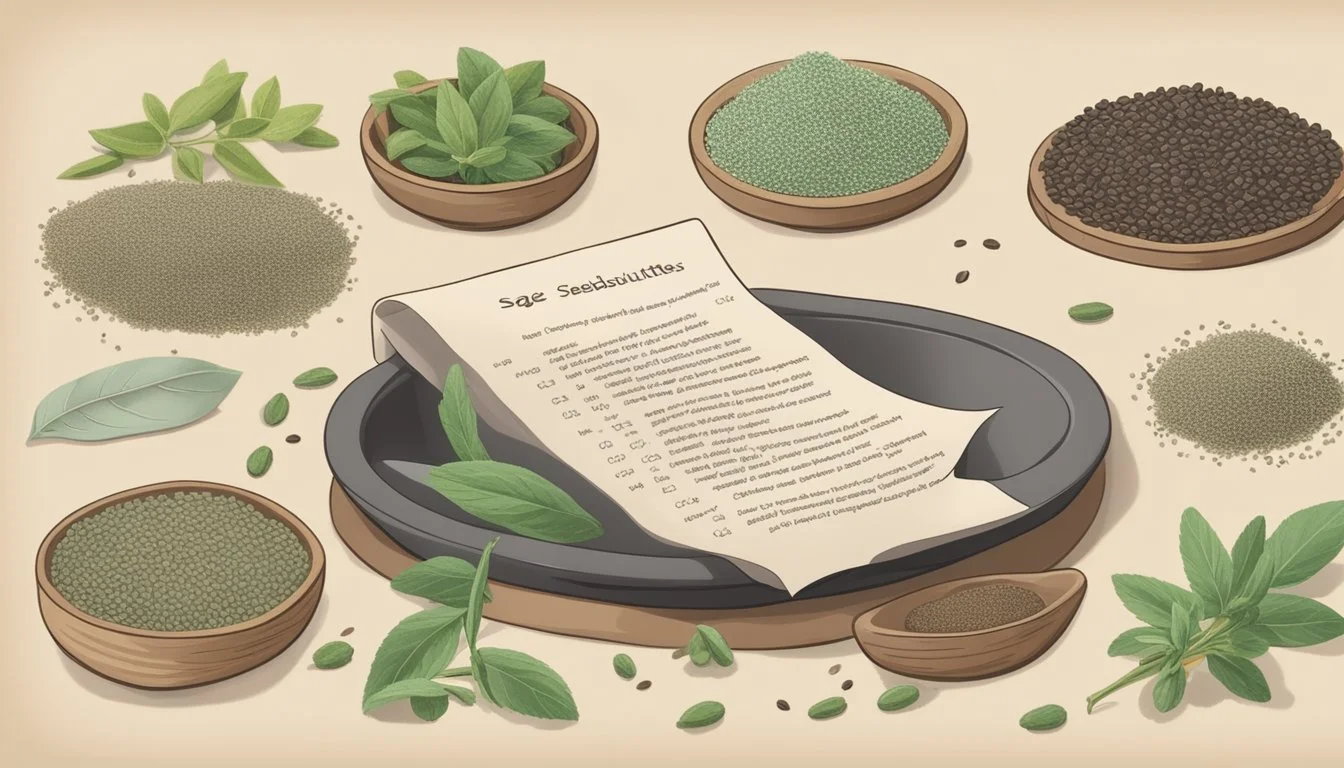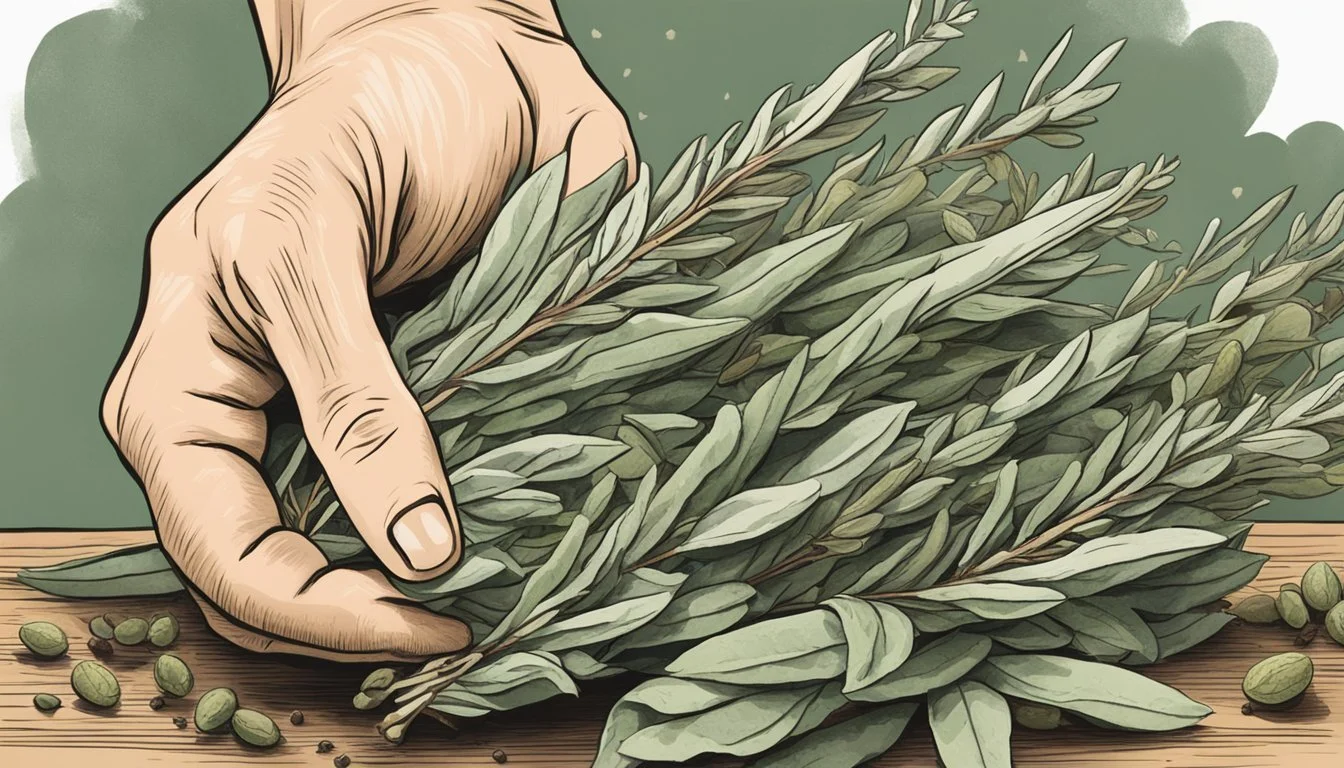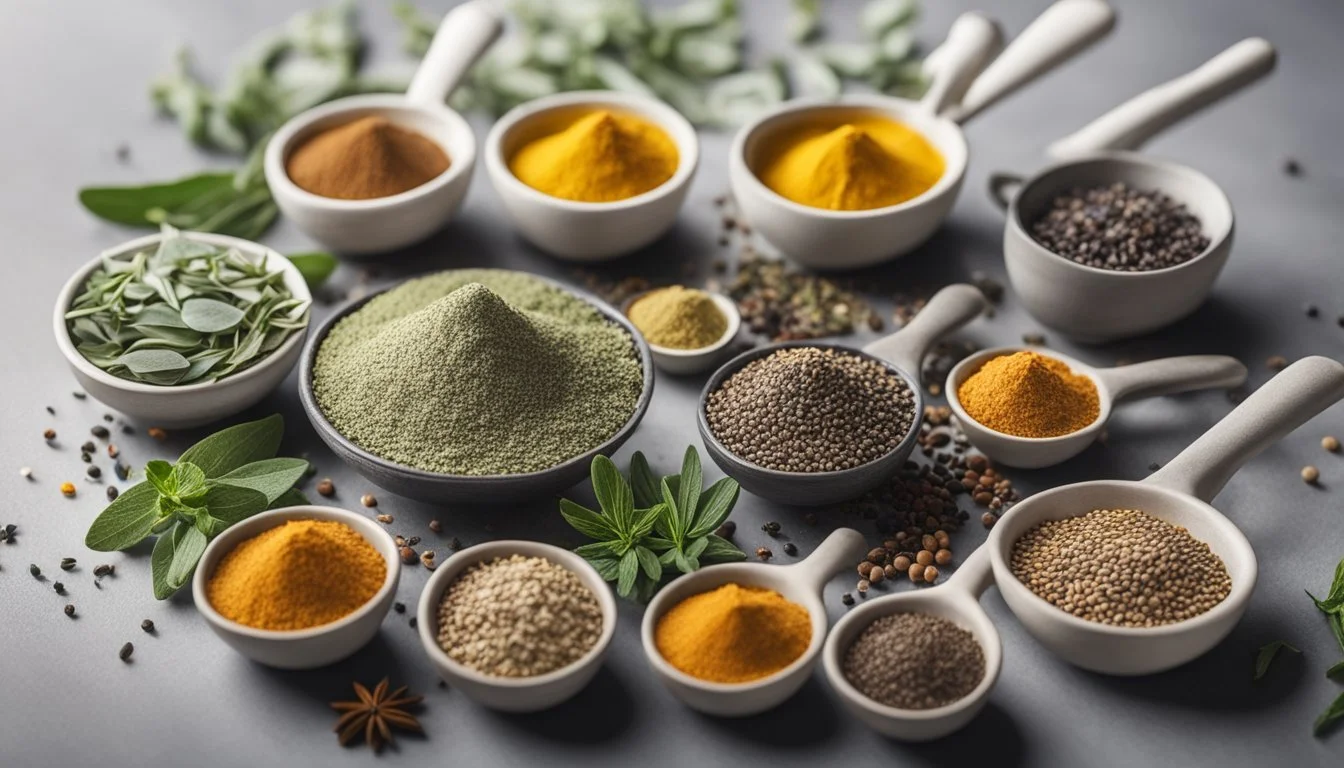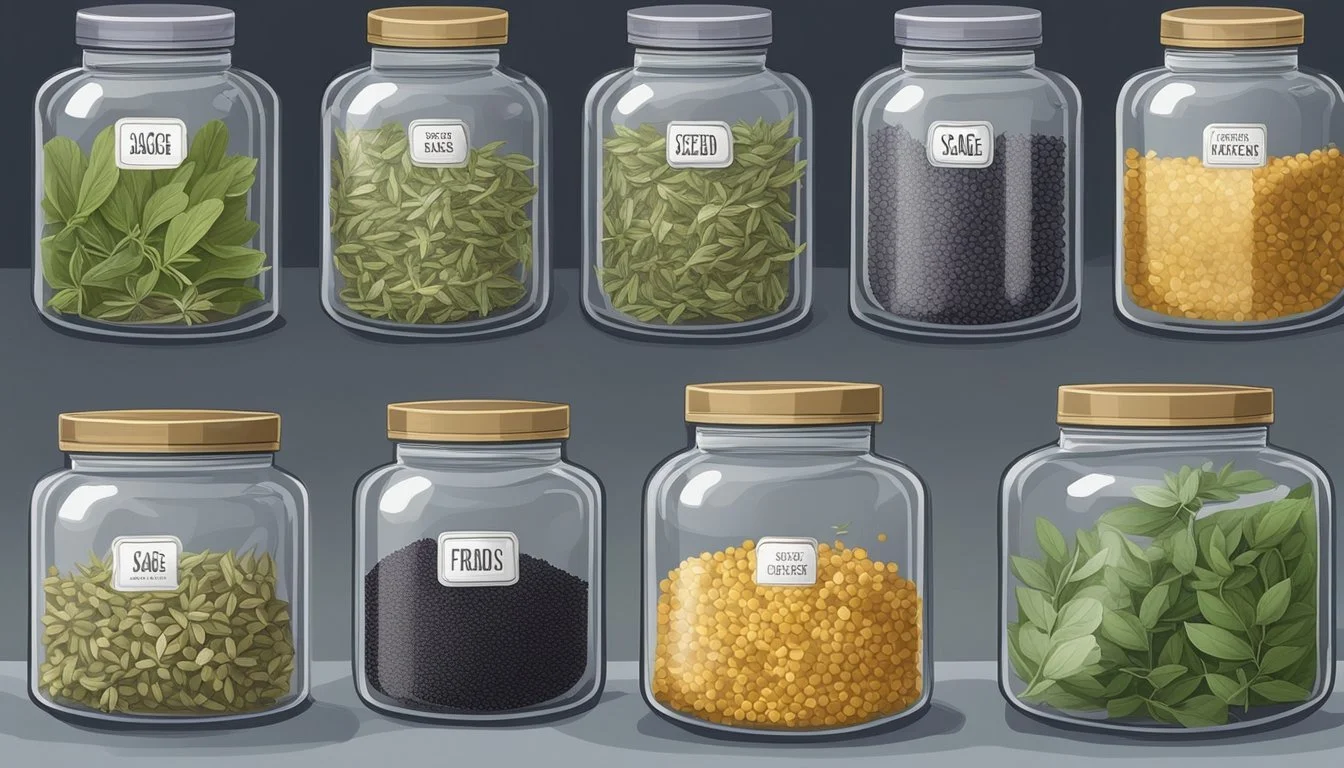Sage Seeds Substitutes
Best Alternatives for Cooking and Health
Sage seeds are a cornerstone in many culinary traditions, but they might not always be available at home. When you're in need of a substitute, several alternatives can provide similar flavors and maintain the integrity of your dish. Rosemary, with its woodsy and citrus notes, is one of the best substitutes for sage seeds, especially when used in smaller quantities to avoid overpowering your meal.
Another viable option is marjoram, which shares a similar earthy flavor and can be used in equal proportions to sage seeds. Thyme also works well, contributing a subtle yet aromatic essence that complements a wide range of recipes. For soups, stews, and poultry dishes, these herbs can easily stand in and provide the needed flavor profile.
In some cases, poultry seasoning can serve as an effective substitute. This blend typically includes herbs like rosemary, marjoram, and thyme, making it a convenient and accessible alternative. Use an equal amount of poultry seasoning as you would with sage seeds to achieve a balanced and flavorful result.
Understanding Sage
Sage, known scientifically as Salvia officinalis, is a highly valued herb. It boasts a strong, earthy aroma and flavor. Widely used in culinary practices, sage also offers several health benefits.
Culinary Uses of Sage
Sage is a staple in various cuisines. It adds a unique, savory touch to dishes. In roasted meats and poultry, sage enhances the flavors with its aromatic profile. Sage is also used in stuffing, sausages, and sauces.
Its versatility makes it a popular choice for Mediterranean and European recipes. Fresh and dried forms of sage are both commonly utilized in cooking. The dried form typically has a more concentrated flavor.
Typical Dishes that Use Sage:
Roasted Poultry
Stuffing
Sausages
Sauces
Health Benefits of Sage
Sage provides numerous health benefits. It contains antioxidants that help combat oxidative stress. Additionally, sage has anti-inflammatory properties which can aid in reducing inflammation.
Sage is also known for its potential cognitive benefits. Studies suggest it may enhance memory and improve brain function. Moreover, sage can support oral health due to its antibacterial properties.
Key Health Benefits:
Antioxidant-rich
Anti-inflammatory
Cognitive enhancement
Oral health support
Characteristics of Sage Flavor
The flavor of sage is robust and aromatic. It features an earthy, slightly peppery taste, with hints of mint and lemon. This strong flavor profile makes it distinct and easily recognizable.
Sage's aroma is equally strong. It brings a warm, woody scent to dishes. Cooks often use it to impart depth and complexity to their meals. When used sparingly, sage can harmonize beautifully with other spices and herbs.
Flavor Profile:
Earthy
Slightly Peppery
Mint and Lemon Hints
Warm, Woody Aroma
In culinary applications, understanding the unique attributes of sage ensures its effective use in various recipes, maximizing both flavor and health benefits.
Choosing the Right Sage Substitute
Selecting an effective sage substitute involves understanding the flavor profiles of alternative herbs and considering their availability and accessibility in stores.
Considering Flavor Profiles
When substituting for sage, attention to flavor profiles is important. Sage has an earthy, slightly peppery taste with hints of mint and eucalyptus. Rosemary can be a suitable substitute, but its more dominant, woodsy notes require smaller usage. Oregano provides a robust, somewhat bitter flavor, suitable for Mediterranean dishes, and can replace sage in equal quantities. Savory, often called the "Canadian sage," combines mint, pepper, thyme, and marjoram flavors, making it an excellent substitute, especially in stews. Dried marjoram offers a milder, sweet taste resembling sage when not overcooked, ideal for delicate recipes.
Availability and Accessibility
Accessibility of sage substitutes in stores affects their usability. Rosemary is widely available fresh or dried and is common in many cuisines, making it an easy find. Oregano is another widely accessible herb, frequently stocked in grocery stores. Savory, though popular in Canadian cooking, might be less common in some regions, requiring a bit more searching. Dried marjoram may pose an availability challenge, as not all stores carry it regularly. Basil, both fresh and dried, might not be a perfect flavor match but can substitute sage in urgent situations due to its widespread availability.
Fresh and Dried Sage Substitutions
To replace fresh or dried sage effectively, consider specific herbs that match sage's flavor profile. Each alternative offers unique characteristics, making them suitable for various recipes.
Fresh Sage Alternatives
Fresh sage has an earthy, slightly peppery taste. Marjoram serves as a great alternative. Use it in place of fresh sage in equal amounts (1 tablespoon of fresh marjoram for 1 tablespoon of fresh sage). Thyme is another excellent substitute with its subtle mint and citrus notes. For fresh thyme, substitute 1 tablespoon for 1 tablespoon of fresh sage. Both herbs work well in poultry dishes, stuffing, and other savory recipes.
Another option is savory, often referred to as the "Canadian sage." It combines mint, pepper, and thyme flavors. Use it in a 1:1 ratio for fresh sage to maintain the dish's intended flavor.
Dried Sage Equivalents
Dried sage has a more concentrated flavor than fresh sage. A common replacement is dried marjoram. Substitute 1 teaspoon of dried marjoram for 1 teaspoon of dried sage. Marjoram's mild, floral undertones make it a suitable match.
Thyme is also excellent for dried sage substitution. Use dried thyme in equal amounts (1 teaspoon of dried thyme for 1 teaspoon of dried sage). Thyme's robust nature pairs well with meats, stews, and sauces.
Poultry seasoning, which often contains sage, marjoram, thyme, and rosemary, can replace dried sage. Use it in equal parts to the amount of dried sage specified in the recipe. This blend enhances the dish’s complexity while maintaining a familiar flavor profile.
Oregano is another substitute, though slightly stronger. Use a ¾:1 ratio (¾ teaspoon of dried oregano for 1 teaspoon of dried sage) to avoid overpowering the dish.
Herbal Substitutes for Sage
Each herb brings unique flavors and aroma to dishes, making certain herbs suitable substitutes for sage based on flavor profiles and culinary uses.
Mediterranean Herbs as Substitutes
Rosemary is a robust herb with a woodsy aroma and hints of pine, pepper, and citrus. Its strong flavor can stand in for sage, particularly in soups, stews, and poultry dishes. Use in smaller quantities due to its potency.
Thyme offers a subtle, earthy flavor with a hint of mint. It pairs well with other spices and can be used in equal parts as a substitute for fresh sage. Perfect for seasoning meats, vegetable dishes, and sauces.
Oregano has a warm, peppery note that complements Mediterranean cuisine. It works well in pasta sauces and meat rubs. When substituting, use ¾ teaspoon of oregano for every teaspoon of sage.
Marjoram is a sweet herb similar to mild oregano. It can be used fresh or dried and is ideal for flavoring soups, meats, and vegetable dishes. It matches the quantity of sage in recipes.
Winter Herbs as Substitutes
Savory offers peppery, thyme-like flavors. It is known as the “Canadian sage” due to its comparable taste profile, making it suitable for roasted meats and hearty winter dishes.
Parsley provides a fresh, mild taste that doesn’t overpower dishes. While different in flavor, it can be a background herb in recipes traditionally calling for sage. Best used fresh.
Bay Leaves are aromatic and add a warm earthiness reminiscent of sage. Ideal for slow-cooking stews, soups, and sauces, bay leaves should be removed before serving, as their texture isn't pleasant when eaten whole.
Tarragon has a slightly sweet, anise-like flavor. It’s best for fish, chicken, and egg dishes. Use fresh or dried tarragon sparingly in place of sage for a unique twist.
Substitutes in Specific Recipes
When looking for sage seed substitutes in various recipes, certain herbs stand out for their ability to complement distinct dishes, ranging from meat and poultry to vegetarian and vegan meals. Each serves a unique purpose, enhancing flavors whether it’s for holiday dishes or everyday cooking.
Meat and Poultry Applications
Rosemary offers a robust, woodsy flavor, making it an excellent replacement in roasted turkey and stuffing. For recipes like pork or chicken, it should be used in smaller quantities to prevent overpowering the dish.
Poultry seasoning: Includes rosemary, thyme, and marjoram, which provide a balanced blend for sausage and glazed turkey.
Thyme: Milder than sage, with a slight citrus note, ideal for soups and stews.
Dosage:
Fresh rosemary: Use half of the required sage amount.
Poultry seasoning: 1 teaspoon for every tablespoon of fresh sage.
Vegetarian and Vegan Alternatives
Basil and marjoram are suitable for vegetarian dishes, providing a pleasant aroma and complementary taste. Basil works well in pasta sauces and baking, offering a hint of cinnamon.
Thyme: Perfect for beans and gnocchi, offering a subtle flavor.
Marjoram: Fresh, with a slightly minty flavor, it can enhance various vegetarian soups and stews.
Dosage:
Basil: Use a 1:1 ratio as a sage substitute.
Marjoram: Slightly less potent, so use a bit more than the required sage amount.
Seasonal Recipe Adaptations
For holiday dishes, rosemary and thyme shine due to their traditional use in hearty, festive meals. Thanksgiving recipes, particularly those involving turkey and stuffing, benefit from these herbs.
Rosemary: Ideal for holiday cooking, providing a strong, pine-like aroma.
Thyme: Versatile for both holiday and everyday meals, especially combined with other seasoning blends in stews and pasta sauces.
Examples:
Roasted turkey: Use rosemary for a festive touch.
Stuffing: Combine thyme and marjoram to mimic sage's complexity.
Consistency in these substitutes ensures flavors remain rich and balanced, maintaining the essence of classic sage-forward recipes without compromising taste or quality.
Non-Herbal Sage Substitutes
When sage seeds are not available, several non-herbal options can provide similar flavor profiles or functionality. These substitutes include a variety of spices and vegetables that closely match sage's unique characteristics.
Spices with Compatible Flavor Notes
Black Pepper: Black pepper can provide a mild peppery and slightly pungent flavor. While it lacks the earthiness of sage, it can add a touch of warmth to dishes like soups and stews.
Nutmeg: Nutmeg offers a slightly sweet and warming flavor. A pinch of ground nutmeg can mimic some of the savory qualities of sage, especially in rich, hearty dishes.
Bay Leaves: Though more floral and subtle in flavor, bay leaves introduce a pine-like and earthy nuance that can emulate sage. Useful in sauces and braised dishes, they should be removed before serving.
Aromatics and Vegetables as Alternatives
Onion: Onions, with their pungent and slightly sweet flavor, can be sautéed to add depth to recipes that typically use sage. This works well in stuffings and casseroles.
Garlic: With its strong, pungent quality, garlic can stand in for the robust taste of sage. Use sparingly to avoid overpowering the dish. It pairs well with meats and roasted vegetables.
Carrots: When cooked down, carrots can add a subtle sweetness and earthiness that complement dishes requiring sage. Their floral notes and mild sweetness make them a versatile substitute in soups.
These spices and aromatics adjust recipes to maintain the intended flavor profile, even in the absence of sage seeds.
Preservation and Storage of Substitutes
Proper storage is crucial in maintaining the freshness and potency of sage substitutes. Each type of herb—whether fresh or dried—has specific storage needs to maximize its shelf life.
Storing Fresh Herbs
Fresh herbs such as oregano, thyme, and marjoram should be stored in the refrigerator. One effective method is to wrap them in a slightly damp paper towel and place them inside a plastic bag. This helps retain moisture and prevents wilting.
Another option is to store them in a glass of water, much like a bouquet of flowers. Trim the stems and place the herbs in the water. Cover the herbs loosely with a plastic bag and keep them in the fridge.
Properly stored, fresh herbs can last about five to seven days. Rotating the water every few days and changing the damp paper towel can extend their shelf life slightly.
Extending the Shelf Life of Dried Substitutes
Dried substitutes like dried sage, rosemary, and poultry seasoning require different storage strategies. These should be kept in airtight containers to preserve their flavor and potency. Glass jars or sealed plastic bags work well for this purpose.
Store the containers in a cool, dark place, away from direct sunlight and heat. This prevents the herbs from losing their volatile oils and flavors. Pantry shelves or cupboards are ideal locations.
For optimal freshness, dried herbs should be used within six months to a year. Labeling the containers with the purchase date can help keep track of their age and ensure the best quality in culinary uses.
Cooking Techniques and Tips
When substituting sage seeds in cooking, it's crucial to adjust ratios properly and maximize flavor with the chosen substitutes.
Adjusting Ratios When Substituting
Accurate ratio adjustments ensure the substitute mimics the flavor and intensity of sage seeds. For instance, rosemary is a potent herb and should be used in smaller quantities to avoid overpowering the dish. A common ratio is using half the amount of rosemary as you would sage seeds. This means if a recipe calls for 1 teaspoon of sage seeds, use 1/2 teaspoon of rosemary.
Marjoram and thyme are milder and can be substituted in a 1:1 ratio. Fresh marjoram or thyme can replace fresh sage seeds directly without altering the quantity. For dried herbs, use one-third the amount of dried substitute compared to fresh sage seeds, as dried herbs are more concentrated.
Maximizing Flavor with Substitutes
Enhancing the flavors when using substitutes involves understanding their culinary properties. Adding substitutes early in the cooking process allows the aromas to infuse into the dish. For example, incorporating rosemary in the early stages of cooking can release its woodsy and peppery notes, blending well with the other ingredients.
For subtler herbs like marjoram, adding them near the end of cooking preserves their delicate flavor. This technique is particularly effective in recipes where a lighter touch is desired. Additionally, consider combining multiple substitutes to balance flavors. Mixing a bit of rosemary with thyme can achieve a complex and nuanced taste profile similar to that of sage seeds.
Use fresh herbs whenever possible to achieve a vibrant and strong flavor. If using dried herbs, consider lightly crushing them to release more aromas before adding them to the dish. This practice enhances the overall flavor integration and ensures a more aromatic result.
Exploring Cultural Variations
Different cultures have their unique approaches to using sage or its substitutes in cooking. This exploration introduces various international herbs and spices that fill a similar role and highlights how traditional dishes incorporate sage.
International Herbs and Spices Similar to Sage
Many herbs and spices from around the world share similar properties to sage and can be used as substitutes.
Italian Seasoning: This blend often includes oregano, rosemary, and thyme, making it a good stand-in for sage in Italian dishes.
Greek Oregano: Known for its robust flavor, it can replace sage in Greek cuisine, especially in meat dishes.
Summer Savory: Commonly used in Canadian cooking, it offers a similar flavor profile.
Mint Family: Including rosemary and marjoram, these are often used when a sage-like flavor is needed in various recipes.
Cilantro and Basil are also notable mentions because they provide fresh and pungent alternatives, fitting well into diverse culinary contexts. Whether used in a pesto or a spicy dish, these herbs adapt to the need for a sage replacement.
Traditional Sage Use in Various Cuisines
Traditional dishes from different regions frequently use sage or similar herbs. In Italian cuisine, sage leaves often garnish pasta or fill ravioli for a classic flavor.
In Greek cuisine, sage complements lamb dishes and sausages, adding depth and aroma.
Canadian cooking sometimes substitutes sage with summer savory in traditional dishes, offering a local twist.
Certain sage mushrooms are also utilized in European recipes to enhance the taste with a mild, earthy flavor.
These traditional practices highlight the significance and adaptability of sage and its substitutes across various culinary traditions. This international perspective not only enriches cooking but also ensures that dietary preferences and local availability do not hamper the creation of beloved dishes.










